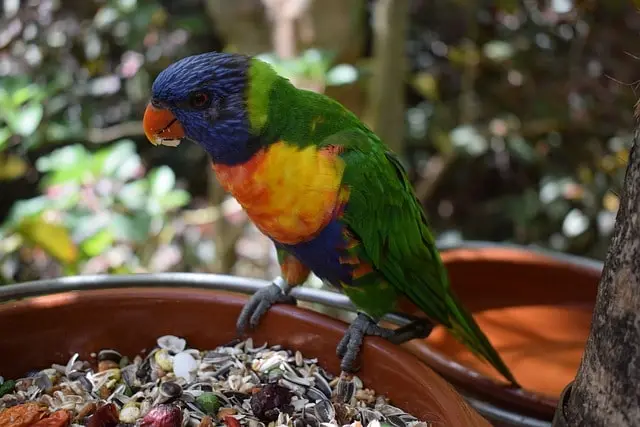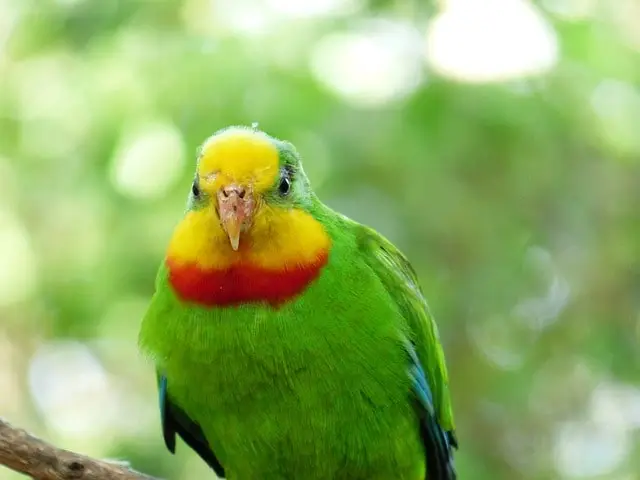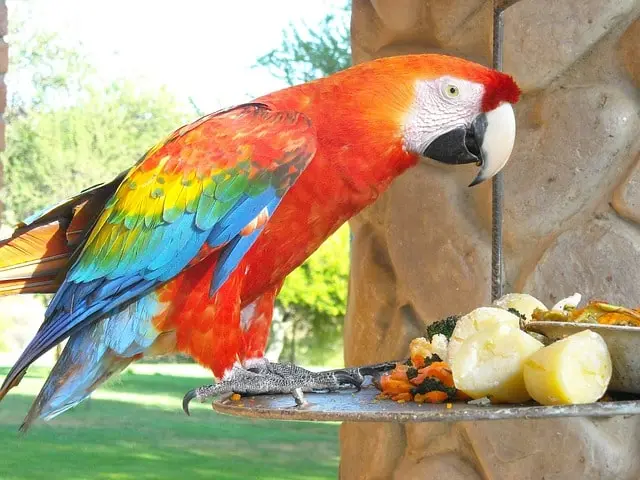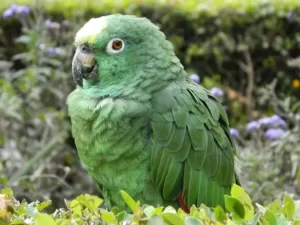Unless you’re weighing your parrot on a regular basis, it is hard to see any changes in weight from just their physical appearance. Feathers can often conceal the signs of weight gain in parrots until the signs of obesity become apparent.
Captive parrots mostly live sedentary lifestyles and do not require as many calories as wild parrots, who routinely have to forage for food. So when a parrot is fed an improper diet, especially without any portion control, it can lead to unhealthy weight gain.
If a parrot becomes overweight, it can pose several health risks and even lead to the development of various diseases. This is why it is so crucial to monitor your parrot’s weight and feed them a healthy diet.
Quick Navigation
What Is Keel Score In Birds?
The keel score is a standard measurement used to assess the body condition of birds. Vets use it to determine if a parrot is overweight, underweight, or healthy.
According to Springer Link, a bird is considered obese when its body weight is approximately 20% higher than the average weight of its species or when it attains a keel score of 4 out of 5.
The keel score can also be used by parrot owners to monitor their birds’ weight. To do this assessment, you can simply feel your parrot’s keel bone. It is located along the chest and slightly extends outward. Based on how easy or difficult it is to feel the breast bone, you can give your parrot a keel score according to the table below:
| Keel Score | Body Condition | Characteristics |
|---|---|---|
| 1 | Emaciated | The keel bone is sharp to the touch. |
| 2 | Underweight | The keel bone can be felt easily, but not too sharp. |
| 3 | Ideal | The keel bone can be felt but it is not sharp. |
| 4 | Overweight | You need to put pressure to feel the keel bone. |
| 5 | Obese | The keep bone is hidden under a layer of fat and cannot be felt. |
What Causes Obesity In Parrots?
An unhealthy diet is the most common reason for obesity in parrots. However, it is not always that simple. There are other factors that can play a role in unhealthy weight gain in parrots.
All-Seed Diet
By far the most common reason for obesity in parrots is feeding a seed-only diet. Still, many parrot owners believe that seeds are a healthy food for birds. This lack of awareness often makes them feed their parrots a diet primarily consisting of seeds. Many people feed their parrots sunflower seeds or a kind of seed mixture.
Seeds are extremely high in fats and lack many important vitamins and minerals that parrots need. A parrot that only eats seeds is likely to suffer from nutritional deficiencies, especially Vitamin A.
It may also develop various health conditions as a result of eating seeds. Not only that, a parrot raised on a seed diet can often turn out to become a seed junkie where it refuses to eat any other food, except seeds.

Too Many Treats
If you have been spoiling your parrot with too many treats, it is likely to gain some extra weight. Treats might seem harmless as it’s usually just one piece or one bite. However, if you let your parrot indulge too much in snacks, it can add up.
This is especially the case with unhealthy human foods that many parrot owners casually share with their parrots. Sharing processed human foods, like chips, cookies, and sugary items can be harmful to your parrot.
Lack Of Excercise
Captive parrots spend most of their time in a closed enclosure, which is often not big enough for flying around. They lead a mostly sedentary lifestyle with a few hours of physical activity.
The only way parrots can engage in any kind of physical activity is when you let them out of their cage. So it’s important that you help your parrot work its muscles on a regular basis by giving it opportunities for flight and encouraging other activities. Otherwise, they will not be able to burn calories which can make them put on weight.
When Is It Normal For Parrots To Gain Weight?
It is normal to see some fluctuation in a parrot’s weight throughout the year. Female parrots commonly gain weight during the breeding season and come back to their normal weight soon after.

Risks Of Obesity In Parrots
Being heavy can increase the likelihood of various joint-related conditions and lead to a poor quality of life. It can also shorten the life expectancy of parrots. In addition to that, obesity in parrots has been associated with many health problems including arthritis/joint pain, fatty liver disease, and diabetes.
Fatty Liver Disease
Fatty liver disease, also known as hepatic lipidosis is a condition characterized by fat build-up in the liver. It is mainly caused by obesity or feeding the bird an only-seed diet. If this condition is not treated in time, it can lead to liver damage and potentially be fatal to the parrot.
Pododermatitis (Bumblefoot)
Bumblefoot is the ulceration of footpads usually caused by a bacterial infection. However, parrots can also develop pressure sores when excess weight is put on the foot for a long period of time.
Obesity can also increase the chances of foot injuries for parrots, such as small cuts and scrapes, which can provide an entry point for the bacteria to invade. Overweight parrots are also prone to injuries as they may routinely lose balance and fall off the perch.
Arthritis
Obesity can accelerate joint problems in parrots. The weight from the parrot’s upper body can put undue stress on its legs joints making them weak and susceptible to chronic conditions like arthritis.
Egg-Binding
Egg-binding and cloacal prolapse can be a risk in overweight female parrots. Even if the bird is not morbidly obese, having extra weight can be risky during egg laying because parrots tend to gain weight around the breeding season. So if a parrot is already overweight, it is more likely to get egg-bound.
During egg-laying, the excess fat around the abdomen can put pressure on the reproductive organs, which can make it difficult for the bird to expel eggs, leading to egg binding. This condition can be painful and life-threatening for the parrot. This is why it is crucial to maintain a healthy weight in parrots.
Respiratory Conditions
Obesity can put parrots at an increased risk of respiratory problems. When a parrot is overweight, its excess body fat can put pressure on its air sacs and make it difficult to breathe efficiently. An overweight parrot might pant more often even when the room temperatures are not hot.
Lipomas
Lipomas are fatty tumors that commonly form under the breastbone of a bird. However, they can develop in any area of the body. They usually develop as small lumps on the parrot’s body and gradually grow larger. If these lumps become large enough, they can hinder a parrot’s flight abilities as well as cause difficulty in perching.
How To Tell If Your Parrot Is Overweight?
There are a few ways you can know if your parrot is overweight or obese. If you do not have a weigh scale at home, using the keel score can be a good way. You can check if your parrot is overweight in the following ways:

Fat Layer Over Breast Bone
Keel bone can be a good way to determine your parrot’s body condition. If you cannot easily feel your parrot’s breast bone, or if it seems to be covered in a thick layer of fat, it could mean that your parrot is overweight.
Weigh Your Parrot
The good way to tell if your parrot is overweight or obese is by having a weight check the next time you visit your veterinarian. The vet can tell you whether your parrot is in the ideal weight range or not, as per the standard weight of its species. A healthy weight for parrots can vary depending on their species since most of them are very different in terms of size.
How To Help A Parrot Lose Weight?
Helping your parrot lose weight involves making the right food choices, and cutting down on calories and fats as much as possible. Dietary modifications are key but they are not the only thing that will help your parrot shed excess weight.
Healthy Diet
A healthy diet for parrots consists of pellets, fruits, and vegetables. Pellets should make up a large portion of your parrot’s diet as they offer a range of nutrients in a balanced way. Fruits and vegetables on the other hand can be a great supplement for parrots providing them with many other essential nutrients.
You should avoid giving any kind of seed or nuts to your parrot. While these are usually fine, it is best to avoid them when your parrot is on a weight-loss diet.
Correct Food Portions
One of the biggest mistakes in feeding parrots is not measuring food portions. If you put out too much food at one time, your parrot can end up overeating, especially if it is something it likes.
And even though parrots know when they’re full, if you continually give them more food than they need, it can make them overeat.
There is no hard and fast rule on the correct food portions for parrots, so you need to determine it yourself. The best way to find out how much your parrot should eat is by trial and error. Here’s how you determine how much food your parrot should eat:
Since parrots are the hungriest when they wake up, you need to use this method in the morning for the most accurate results.
First, weigh the food before you serve it to your parrot. Then, observe them as they eat. When parrots are hungry, they will eat quickly without wasting a lot of food.
However, they can start to slow down after a point even though they do not realize that they are full. At this point, the parrot may start throwing more food around and would eat slower.
You can weigh the food that has been left over after your parrot slows down and subtract it from the base weight of the food you initially served. This will give you the amount of food your parrot ate before it was full. You can repeat this process a few times, ideally for a week, to fine-tune the portion size.
Add More Fruits To The Diet
Fruits are ideal for helping your parrot lose weight. They are low in calories but pack a good amount of nutrition. You can cut down on other calorically dense foods and switch them with fruits. Fruits can provide your parrot with the essential nutrients they need and fulfill their daily intake.
Regular Excercise
You should let your parrot out of its cage more often, at least twice a day so it can engage in physical activities on its own. Flying can be a great form of exercise for parrots. You can encourage your parrot to fly towards you, but avoid using treats as an encouragement since we’re trying to make them lose weight.
Some parrot owners clip their parrot’s wings, and that might not help with their condition. A parrot with its wings clipped will have a more inactive lifestyle which can promote obesity. And it can be a while before your parrot regrows its clipped feathers since it only happens during the molting season.
Provide More Toys
You can also encourage your parrot to spend their energies engaging in creative and fun activities that keep them occupied for a longer period. Like parrots in the wild, pet parrots also like to be busy and work for their food.
It stimulates their appetite and also helps them burn more calories. Providing your parrot with lots of toys and foraging opportunities in their cage can keep them mentally stimulated as well as physically active.







